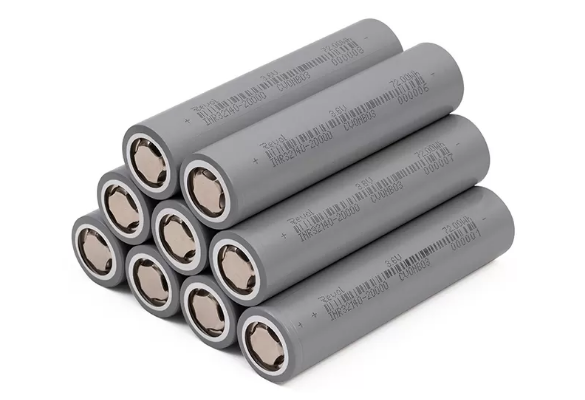What is the Difference Between IMR, ICR, INR, and IFR 18650 Battery?
Understanding the distinctions among IMR, ICR, INR, and IFR 18650 batteries is essential for choosing the right battery for your requirements. Each type showcases a unique chemical makeup and performance characteristics, underscoring the importance of selecting the appropriate variant for optimal use. Recent searches indicate that the main differences hinge on chemical composition, safety features, energy density, and ideal applications for each type of battery. This article thoroughly explores IMR, ICR, INR, and IFR 18650 batteries, highlighting their distinct properties and intended uses.

Part 1: IMR 18650 Battery
I: Lithium (Li)
M: Manganese (Mn)
R: Round Cell (R)
Chemical Composition
IMR 18650 batteries, or "Lithium Manganese Oxide Rechargeable," utilize lithium manganese oxide (LiMn₂O₄) as their cathode. This specific chemical structure contributes to their distinctive features that impact performance and safety.
Advantages
- Enhanced Safety: The lithium manganese oxide chemistry promotes safety by significantly lowering the risk of thermal runaway and improving stability during charging and discharging processes.
- Lower Internal Resistance: IMR batteries benefit from reduced internal resistance, permitting high discharge rates. This trait makes them suitable for high-drain devices requiring rapid power bursts, like vaping products and powerful flashlights.
Disadvantages
- Energy Density Concerns: Compared to other 18650 variants, IMR batteries may display a slightly reduced energy density, which might affect overall battery life or capacity, making them less ideal for prolonged, low-power applications.
Applications
IMR 18650 batteries find common application in devices necessitating immediate energy delivery, including:
- Vaping Mods: Their capability to quickly discharge power makes IMR batteries a favored choice among vapers, offering swift energy bursts for vaporization.
- Portable Lighting Systems: IMR batteries are advantageous for high-performance flashlights and portable lighting setups, as they can swiftly provide high power when needed.
- Power Tools: Tools like power drills and saws that require immediate and significant power bursts benefit greatly from IMR batteries due to their high-drain capability.
Part 2: ICR 18650 Battery
I: Lithium (Li)
C: Cobalt (Co)
R: Round Cell (R)
Chemical Composition
ICR 18650 batteries, referred to as "Lithium Cobalt Oxide Rechargeable," employ lithium cobalt oxide (LiCoO₂) as their cathode. This distinct chemical configuration is vital to their performance and safety characteristics.
Advantages
- High Energy Density: ICR batteries are noted for their remarkable energy density, enabling them to store considerable amounts of energy compared to many other 18650 types.
Disadvantages
- Safety Concerns: The lithium cobalt oxide chemistry can lead to safety issues, especially in high-drain contexts. ICR batteries are more susceptible to overheating and instability, necessitating careful safety oversight.
- Lower Discharge Rates: Usually, these batteries show lower discharge rates than certain types like IMR, which can restrict their effectiveness in applications needing rapid power delivery.
Applications
ICR 18650 batteries excel in scenarios demanding high capacity over immediate high power delivery:
- Consumer Electronics: Devices such as laptops, digital cameras, and other portable electronics benefit from ICR batteries due to their high capacity offering stable power for extended periods.
- Low-Drain Devices: ICR batteries are commonly utilized in gadgets that depend on steady but not urgent power, including certain medical devices or low-powered flashlights.
Part 3: INR 18650 Battery
I: Lithium (Li)
N: Nickel (Ni)
R: Round Cell (R)
Chemical Composition
INR 18650 batteries, recognized as "Lithium Nickel Manganese Cobalt Oxide Rechargeable," combine nickel, manganese, and cobalt in their cathode composition. This unique mixture directly affects their performance and stability.
Advantages
- Balanced Performance: INR batteries provide a good balance between energy capacity and discharge rates, ensuring adequate power output along with reasonable energy storage.
- Improved Stability: Compared to ICR variants, INR batteries demonstrate greater stability and are less likely to overheat, especially during high-drain usage.
Disadvantages
- Moderate Energy Density: INR batteries may have slightly lower energy density compared to some other types, affecting total capacity and runtime.
- Moderate Capacity: Even though they are more balanced, INR cells might not deliver the same high capacity as ICR batteries, limiting their desirability for maximum energy storage applications.
Applications
INR 18650 batteries are ideal for devices needing a balance between energy capacity and power output:
- Portable Electronics: Laptops, power banks, and certain electronic tools utilize INR batteries for their capacity to provide stable power over moderate durations.
- Moderate-Drain Devices: Equipment like mid-range flashlights or moderate-power appliances typically uses INR batteries, which offer a favorable mix between energy capacity and power output.
Part 4: IFR 18650 Battery
I: Lithium (Li)
F: Iron (Fe)
R: Round Cell (R)
Chemical Composition
IFR 18650 batteries, representing "Lithium Iron Phosphate Rechargeable," feature lithium iron phosphate (LiFePO4) as their cathode. This particular composition distinguishes them from other 18650 types, providing unique performance attributes.
Advantages
- Enhanced Safety: Renowned for their exemplary safety attributes, IFR batteries significantly diminish the risk of thermal runaway and instability, making them one of the safest battery options available.
- Longevity: These batteries feature an extended cycle life, surpassing other 18650 variants in durability, rendering them ideal for long-term applications.
Disadvantages
- Lower Energy Density: Compared to other 18650 types, IFR batteries have a reduced energy density, indicating they can store less energy relative to their size.
- Moderate Discharge Rates: While providing stable performance, IFR batteries might not be ideal for applications demanding rapid power delivery, given their lower discharge rates compared to high-drain alternatives like IMR.
Applications
IFR 18650 batteries are particularly effective in devices that prioritize safety and longevity:
- Solar Power Storage: Their high level of safety and long lifespan make IFR batteries excellent choices for solar energy storage systems, where reliability over extended periods is paramount.
- Electric Vehicles: Electric cars, bikes, and scooters utilize IFR batteries for their dependable and stable performance, ensuring consistent, long-lasting energy in demanding contexts.
Part 5: Differences Between IMR, ICR, INR, and IFR 18650 Batteries
Similarities
- All Lithium-Ion: IMR, ICR, INR, and IFR batteries belong to the lithium-ion family and utilize lithium-based chemistries.
- Rechargeable: Each battery type is rechargeable, capable of multiple charging and discharging cycles before needing replacement.
Differences
1. Chemical Composition
- IMR: Lithium Manganese Oxide (LiMn₂O₄)
- ICR: Lithium Cobalt Oxide (LiCoO₂)
- INR: Lithium Nickel Manganese Cobalt Oxide
- IFR: Lithium Iron Phosphate (LiFePO₄)
2. Performance Characteristics
- IMR: Features lower internal resistance for higher discharge rates, suitable for high-drain devices.
- ICR: High capacity but safety risks due to potential overheating in high-drain situations.
- INR: Balances capacity and discharge rates, fitting for moderate-drain devices.
- IFR: Focuses on safety, stability, and durability, though exhibiting lower capacity and discharge rates.
3. Applications
- IMR: Best for high-drain devices like vaping mods, power tools, and high-powered flashlights.
- ICR: Utilized in low-drain devices such as laptops, digital cameras, and various portable electronics.
- INR: Optimal for moderate-drain applications like laptops, power banks, and mid-power tools.
- IFR: Frequently employed in solar energy storage systems, electric vehicles, and applications where safety and long life are crucial.
4. Safety and Longevity
- IMR & IFR: Generally regarded as safer than ICR due to their stable chemistries, with IFR especially excelling in safety and long cycle life.
- INR: Offers a balanced compromise among safety, performance, and moderate longevity.
- ICR: Requires careful safety management, particularly in high-drain contexts where overheating presents risks.


Comments